Reflective Report and Action Plan: Personal Brand & Competence
VerifiedAdded on 2022/08/22
|12
|2770
|26
Report
AI Summary
This reflective report and action plan analyzes a student's personal brand, focusing on self-assessment, skills, and career aspirations as an accountant. The report utilizes models like the Six Thinking Hats and Gibbs Reflective Cycle to evaluate strengths, weaknesses, and areas for improvement. It incl...
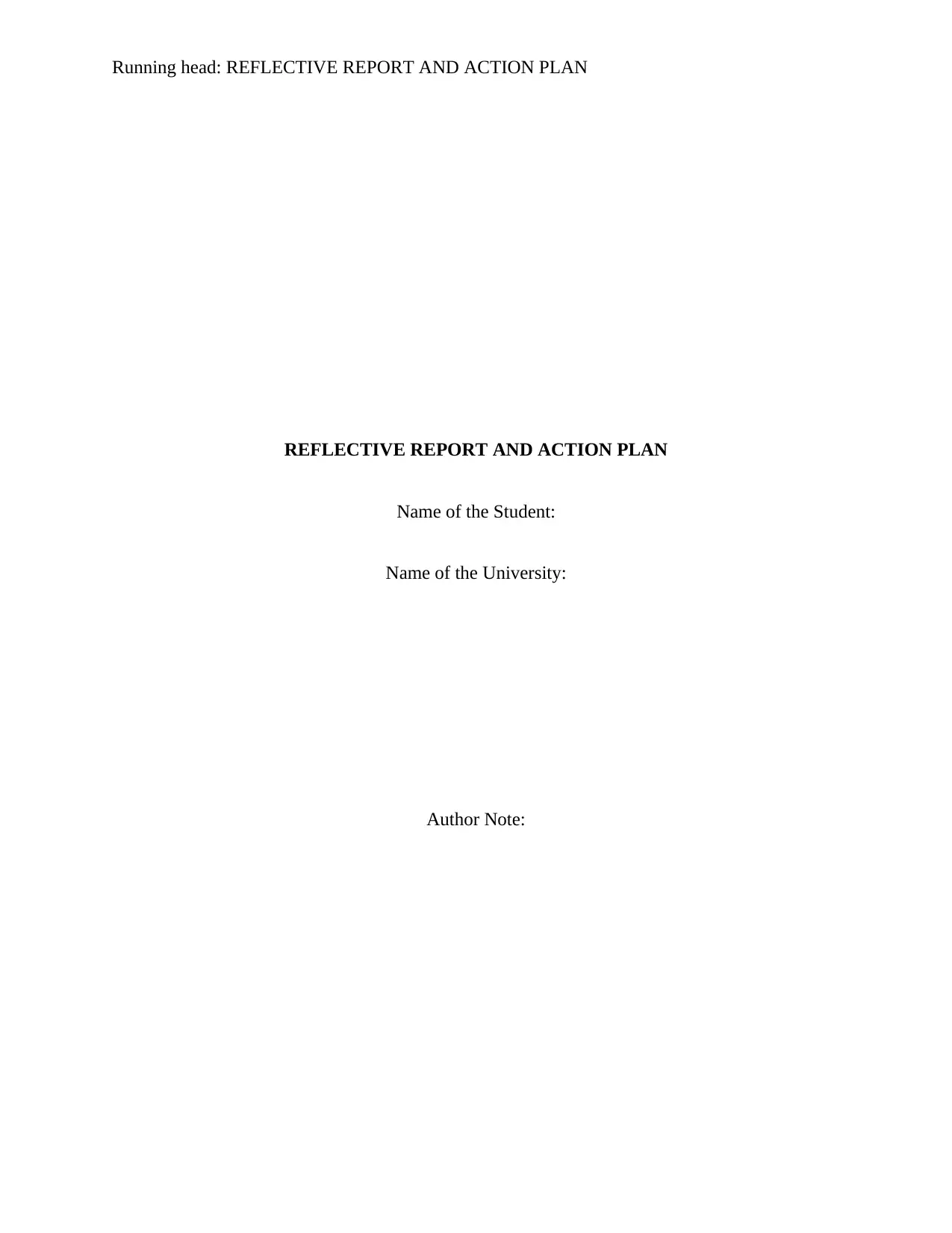
Running head: REFLECTIVE REPORT AND ACTION PLAN
REFLECTIVE REPORT AND ACTION PLAN
Name of the Student:
Name of the University:
Author Note:
REFLECTIVE REPORT AND ACTION PLAN
Name of the Student:
Name of the University:
Author Note:
Paraphrase This Document
Need a fresh take? Get an instant paraphrase of this document with our AI Paraphraser
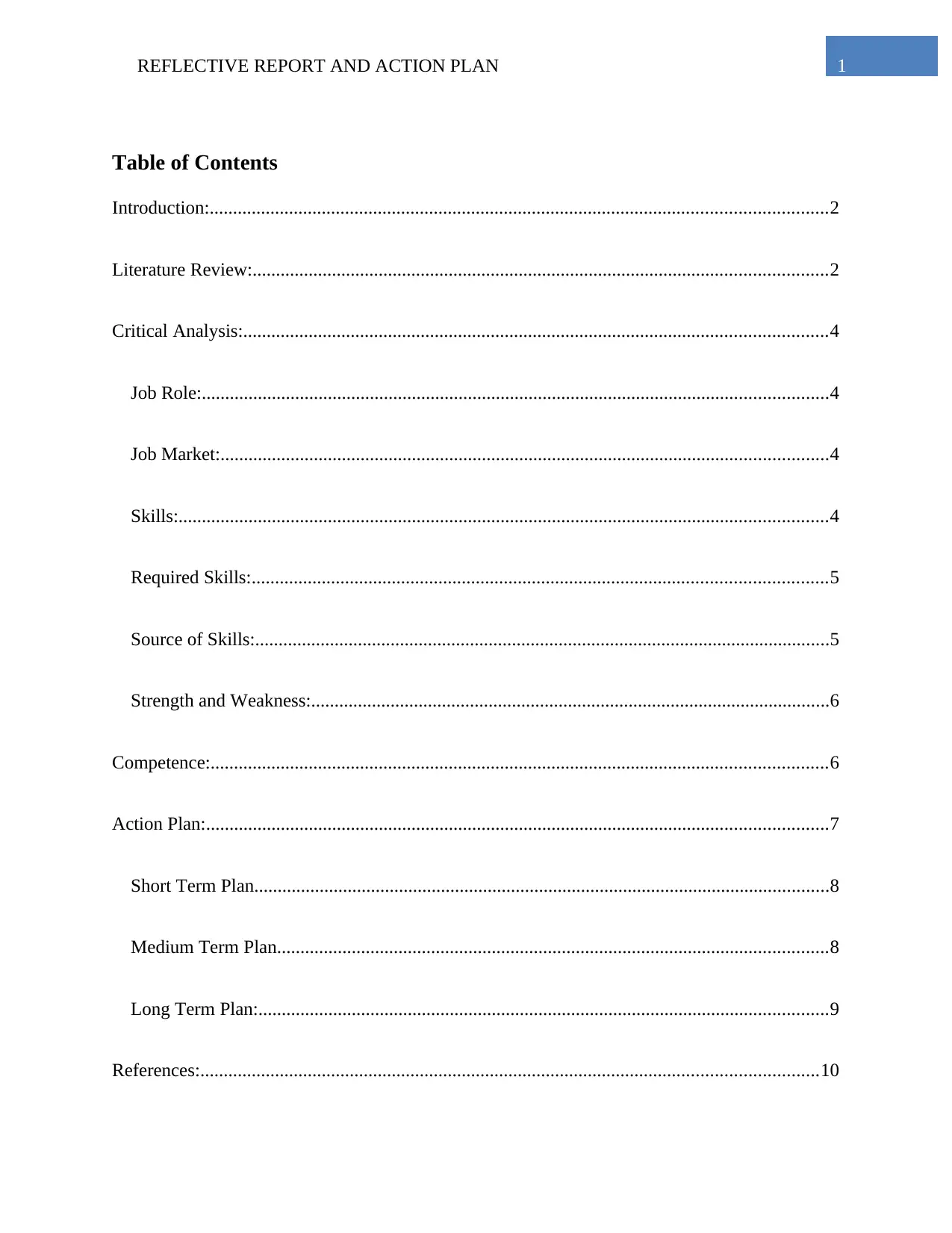
1REFLECTIVE REPORT AND ACTION PLAN
Table of Contents
Introduction:....................................................................................................................................2
Literature Review:...........................................................................................................................2
Critical Analysis:.............................................................................................................................4
Job Role:......................................................................................................................................4
Job Market:..................................................................................................................................4
Skills:...........................................................................................................................................4
Required Skills:...........................................................................................................................5
Source of Skills:...........................................................................................................................5
Strength and Weakness:...............................................................................................................6
Competence:....................................................................................................................................6
Action Plan:.....................................................................................................................................7
Short Term Plan...........................................................................................................................8
Medium Term Plan......................................................................................................................8
Long Term Plan:..........................................................................................................................9
References:....................................................................................................................................10
Table of Contents
Introduction:....................................................................................................................................2
Literature Review:...........................................................................................................................2
Critical Analysis:.............................................................................................................................4
Job Role:......................................................................................................................................4
Job Market:..................................................................................................................................4
Skills:...........................................................................................................................................4
Required Skills:...........................................................................................................................5
Source of Skills:...........................................................................................................................5
Strength and Weakness:...............................................................................................................6
Competence:....................................................................................................................................6
Action Plan:.....................................................................................................................................7
Short Term Plan...........................................................................................................................8
Medium Term Plan......................................................................................................................8
Long Term Plan:..........................................................................................................................9
References:....................................................................................................................................10
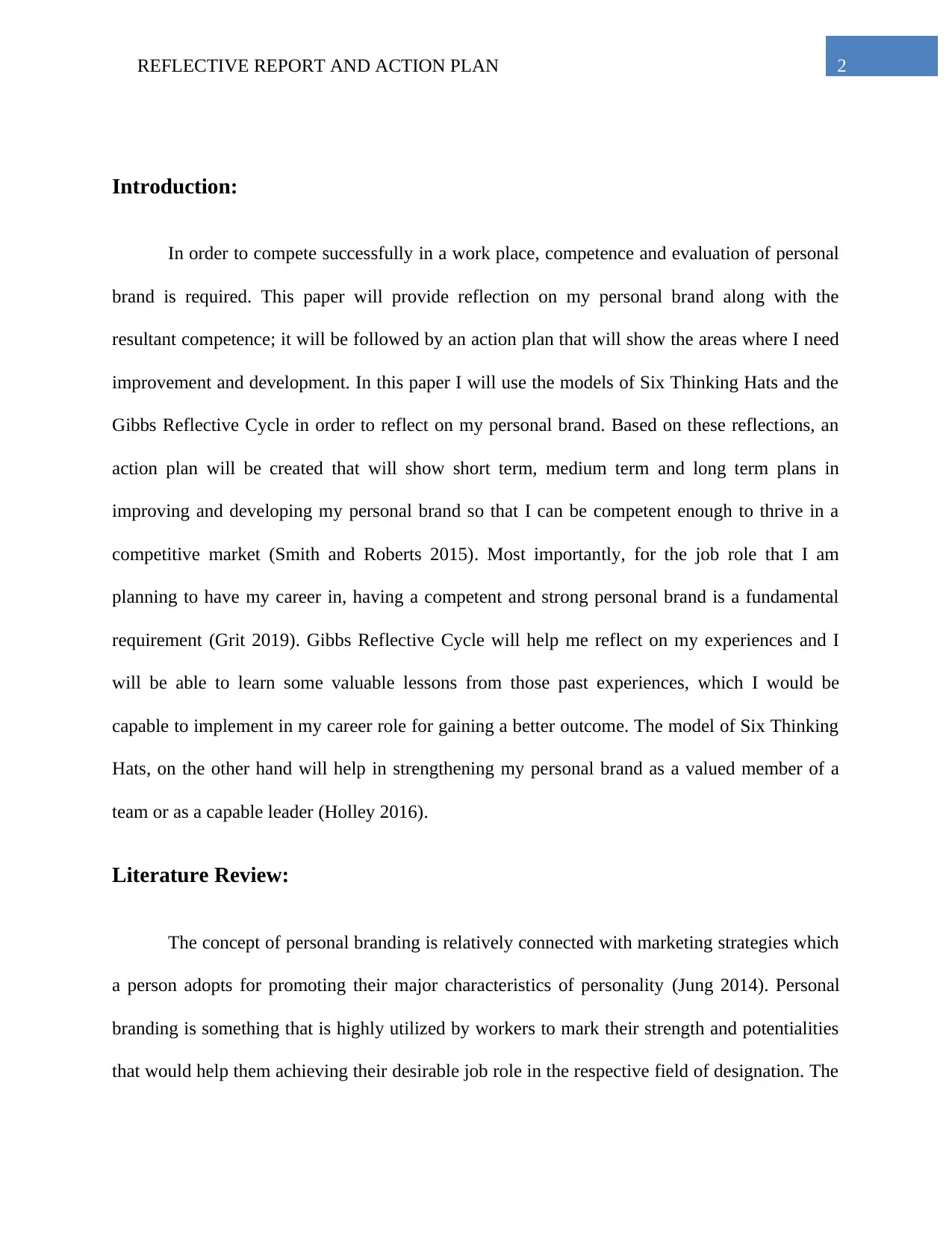
2REFLECTIVE REPORT AND ACTION PLAN
Introduction:
In order to compete successfully in a work place, competence and evaluation of personal
brand is required. This paper will provide reflection on my personal brand along with the
resultant competence; it will be followed by an action plan that will show the areas where I need
improvement and development. In this paper I will use the models of Six Thinking Hats and the
Gibbs Reflective Cycle in order to reflect on my personal brand. Based on these reflections, an
action plan will be created that will show short term, medium term and long term plans in
improving and developing my personal brand so that I can be competent enough to thrive in a
competitive market (Smith and Roberts 2015). Most importantly, for the job role that I am
planning to have my career in, having a competent and strong personal brand is a fundamental
requirement (Grit 2019). Gibbs Reflective Cycle will help me reflect on my experiences and I
will be able to learn some valuable lessons from those past experiences, which I would be
capable to implement in my career role for gaining a better outcome. The model of Six Thinking
Hats, on the other hand will help in strengthening my personal brand as a valued member of a
team or as a capable leader (Holley 2016).
Literature Review:
The concept of personal branding is relatively connected with marketing strategies which
a person adopts for promoting their major characteristics of personality (Jung 2014). Personal
branding is something that is highly utilized by workers to mark their strength and potentialities
that would help them achieving their desirable job role in the respective field of designation. The
Introduction:
In order to compete successfully in a work place, competence and evaluation of personal
brand is required. This paper will provide reflection on my personal brand along with the
resultant competence; it will be followed by an action plan that will show the areas where I need
improvement and development. In this paper I will use the models of Six Thinking Hats and the
Gibbs Reflective Cycle in order to reflect on my personal brand. Based on these reflections, an
action plan will be created that will show short term, medium term and long term plans in
improving and developing my personal brand so that I can be competent enough to thrive in a
competitive market (Smith and Roberts 2015). Most importantly, for the job role that I am
planning to have my career in, having a competent and strong personal brand is a fundamental
requirement (Grit 2019). Gibbs Reflective Cycle will help me reflect on my experiences and I
will be able to learn some valuable lessons from those past experiences, which I would be
capable to implement in my career role for gaining a better outcome. The model of Six Thinking
Hats, on the other hand will help in strengthening my personal brand as a valued member of a
team or as a capable leader (Holley 2016).
Literature Review:
The concept of personal branding is relatively connected with marketing strategies which
a person adopts for promoting their major characteristics of personality (Jung 2014). Personal
branding is something that is highly utilized by workers to mark their strength and potentialities
that would help them achieving their desirable job role in the respective field of designation. The
⊘ This is a preview!⊘
Do you want full access?
Subscribe today to unlock all pages.

Trusted by 1+ million students worldwide
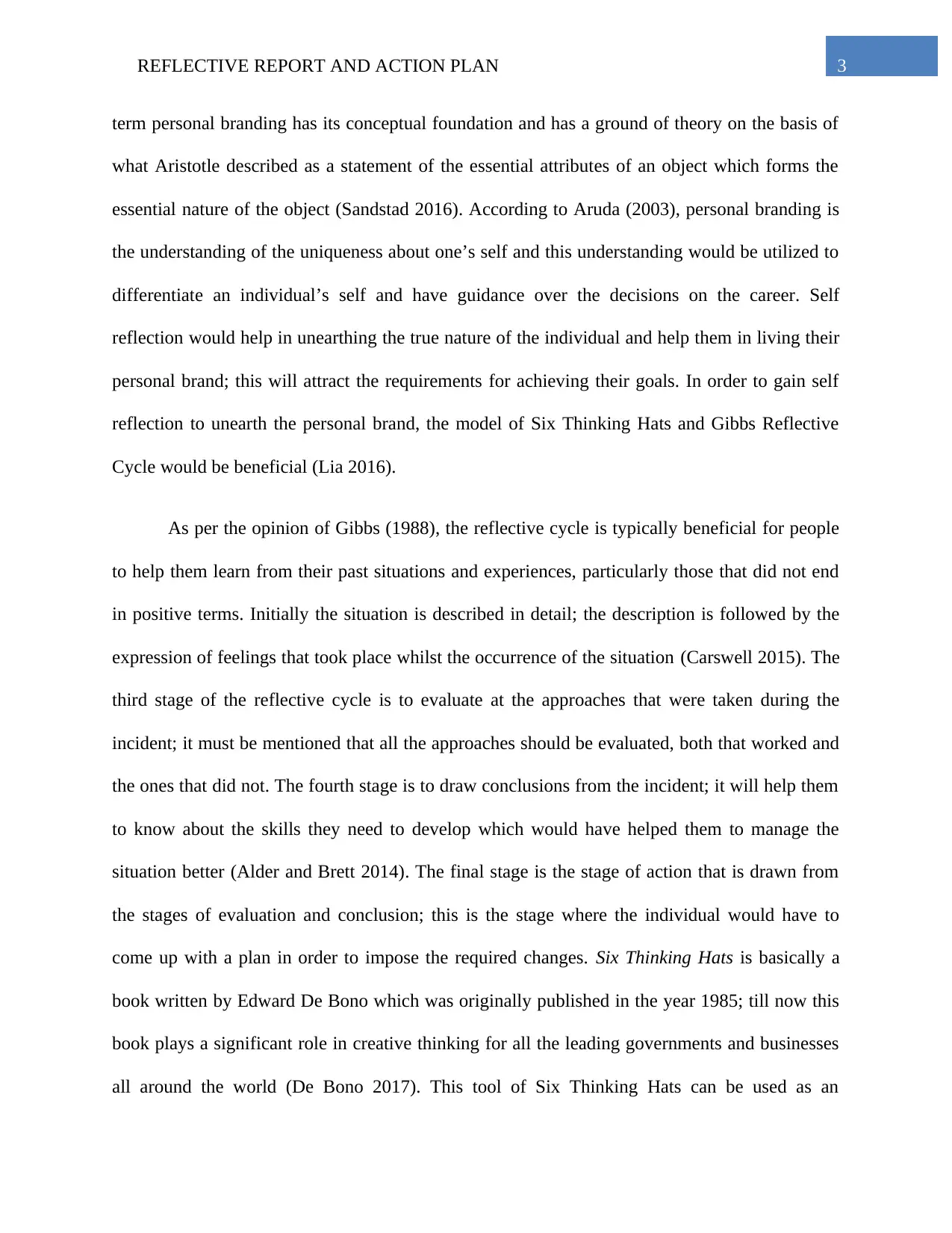
3REFLECTIVE REPORT AND ACTION PLAN
term personal branding has its conceptual foundation and has a ground of theory on the basis of
what Aristotle described as a statement of the essential attributes of an object which forms the
essential nature of the object (Sandstad 2016). According to Aruda (2003), personal branding is
the understanding of the uniqueness about one’s self and this understanding would be utilized to
differentiate an individual’s self and have guidance over the decisions on the career. Self
reflection would help in unearthing the true nature of the individual and help them in living their
personal brand; this will attract the requirements for achieving their goals. In order to gain self
reflection to unearth the personal brand, the model of Six Thinking Hats and Gibbs Reflective
Cycle would be beneficial (Lia 2016).
As per the opinion of Gibbs (1988), the reflective cycle is typically beneficial for people
to help them learn from their past situations and experiences, particularly those that did not end
in positive terms. Initially the situation is described in detail; the description is followed by the
expression of feelings that took place whilst the occurrence of the situation (Carswell 2015). The
third stage of the reflective cycle is to evaluate at the approaches that were taken during the
incident; it must be mentioned that all the approaches should be evaluated, both that worked and
the ones that did not. The fourth stage is to draw conclusions from the incident; it will help them
to know about the skills they need to develop which would have helped them to manage the
situation better (Alder and Brett 2014). The final stage is the stage of action that is drawn from
the stages of evaluation and conclusion; this is the stage where the individual would have to
come up with a plan in order to impose the required changes. Six Thinking Hats is basically a
book written by Edward De Bono which was originally published in the year 1985; till now this
book plays a significant role in creative thinking for all the leading governments and businesses
all around the world (De Bono 2017). This tool of Six Thinking Hats can be used as an
term personal branding has its conceptual foundation and has a ground of theory on the basis of
what Aristotle described as a statement of the essential attributes of an object which forms the
essential nature of the object (Sandstad 2016). According to Aruda (2003), personal branding is
the understanding of the uniqueness about one’s self and this understanding would be utilized to
differentiate an individual’s self and have guidance over the decisions on the career. Self
reflection would help in unearthing the true nature of the individual and help them in living their
personal brand; this will attract the requirements for achieving their goals. In order to gain self
reflection to unearth the personal brand, the model of Six Thinking Hats and Gibbs Reflective
Cycle would be beneficial (Lia 2016).
As per the opinion of Gibbs (1988), the reflective cycle is typically beneficial for people
to help them learn from their past situations and experiences, particularly those that did not end
in positive terms. Initially the situation is described in detail; the description is followed by the
expression of feelings that took place whilst the occurrence of the situation (Carswell 2015). The
third stage of the reflective cycle is to evaluate at the approaches that were taken during the
incident; it must be mentioned that all the approaches should be evaluated, both that worked and
the ones that did not. The fourth stage is to draw conclusions from the incident; it will help them
to know about the skills they need to develop which would have helped them to manage the
situation better (Alder and Brett 2014). The final stage is the stage of action that is drawn from
the stages of evaluation and conclusion; this is the stage where the individual would have to
come up with a plan in order to impose the required changes. Six Thinking Hats is basically a
book written by Edward De Bono which was originally published in the year 1985; till now this
book plays a significant role in creative thinking for all the leading governments and businesses
all around the world (De Bono 2017). This tool of Six Thinking Hats can be used as an
Paraphrase This Document
Need a fresh take? Get an instant paraphrase of this document with our AI Paraphraser
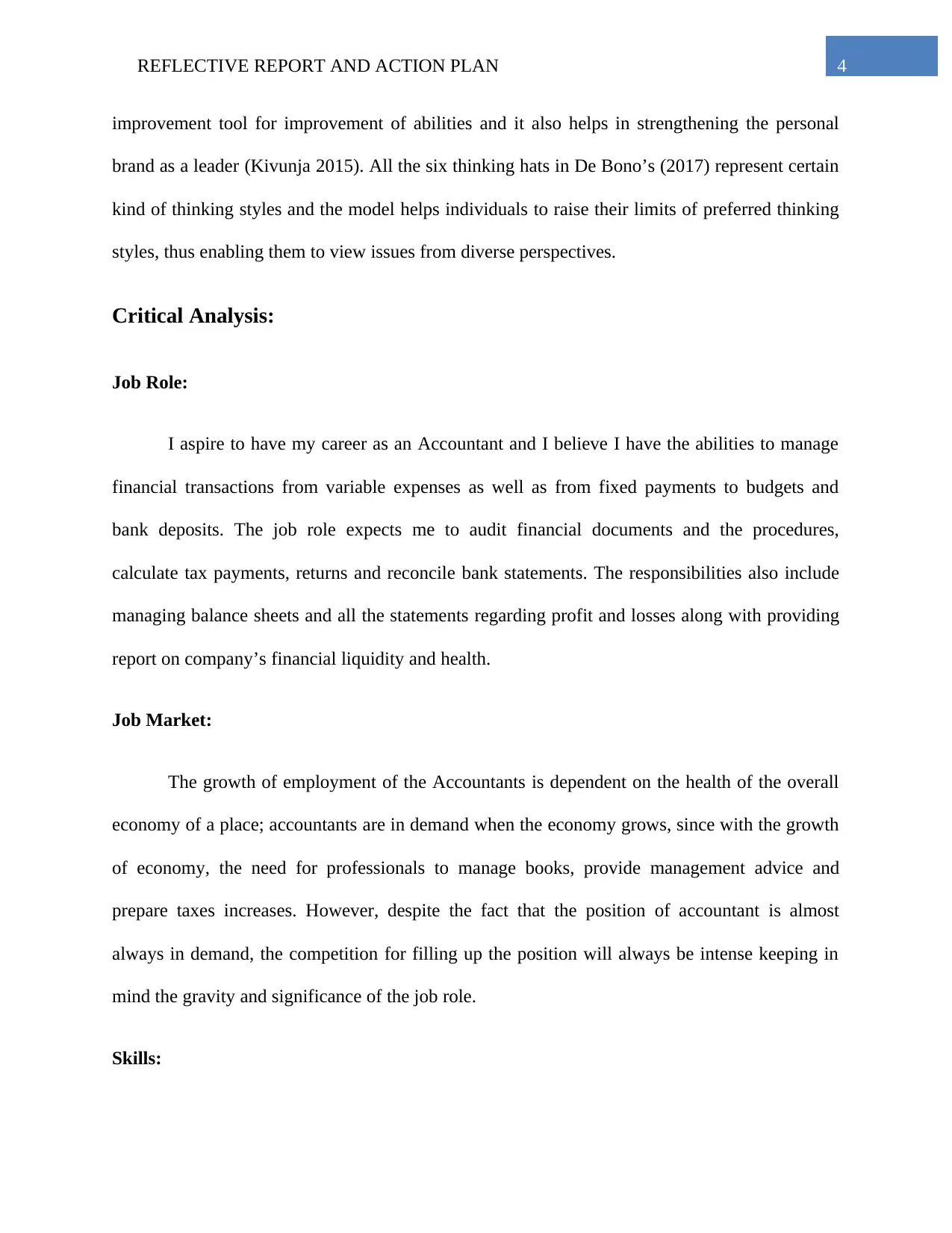
4REFLECTIVE REPORT AND ACTION PLAN
improvement tool for improvement of abilities and it also helps in strengthening the personal
brand as a leader (Kivunja 2015). All the six thinking hats in De Bono’s (2017) represent certain
kind of thinking styles and the model helps individuals to raise their limits of preferred thinking
styles, thus enabling them to view issues from diverse perspectives.
Critical Analysis:
Job Role:
I aspire to have my career as an Accountant and I believe I have the abilities to manage
financial transactions from variable expenses as well as from fixed payments to budgets and
bank deposits. The job role expects me to audit financial documents and the procedures,
calculate tax payments, returns and reconcile bank statements. The responsibilities also include
managing balance sheets and all the statements regarding profit and losses along with providing
report on company’s financial liquidity and health.
Job Market:
The growth of employment of the Accountants is dependent on the health of the overall
economy of a place; accountants are in demand when the economy grows, since with the growth
of economy, the need for professionals to manage books, provide management advice and
prepare taxes increases. However, despite the fact that the position of accountant is almost
always in demand, the competition for filling up the position will always be intense keeping in
mind the gravity and significance of the job role.
Skills:
improvement tool for improvement of abilities and it also helps in strengthening the personal
brand as a leader (Kivunja 2015). All the six thinking hats in De Bono’s (2017) represent certain
kind of thinking styles and the model helps individuals to raise their limits of preferred thinking
styles, thus enabling them to view issues from diverse perspectives.
Critical Analysis:
Job Role:
I aspire to have my career as an Accountant and I believe I have the abilities to manage
financial transactions from variable expenses as well as from fixed payments to budgets and
bank deposits. The job role expects me to audit financial documents and the procedures,
calculate tax payments, returns and reconcile bank statements. The responsibilities also include
managing balance sheets and all the statements regarding profit and losses along with providing
report on company’s financial liquidity and health.
Job Market:
The growth of employment of the Accountants is dependent on the health of the overall
economy of a place; accountants are in demand when the economy grows, since with the growth
of economy, the need for professionals to manage books, provide management advice and
prepare taxes increases. However, despite the fact that the position of accountant is almost
always in demand, the competition for filling up the position will always be intense keeping in
mind the gravity and significance of the job role.
Skills:
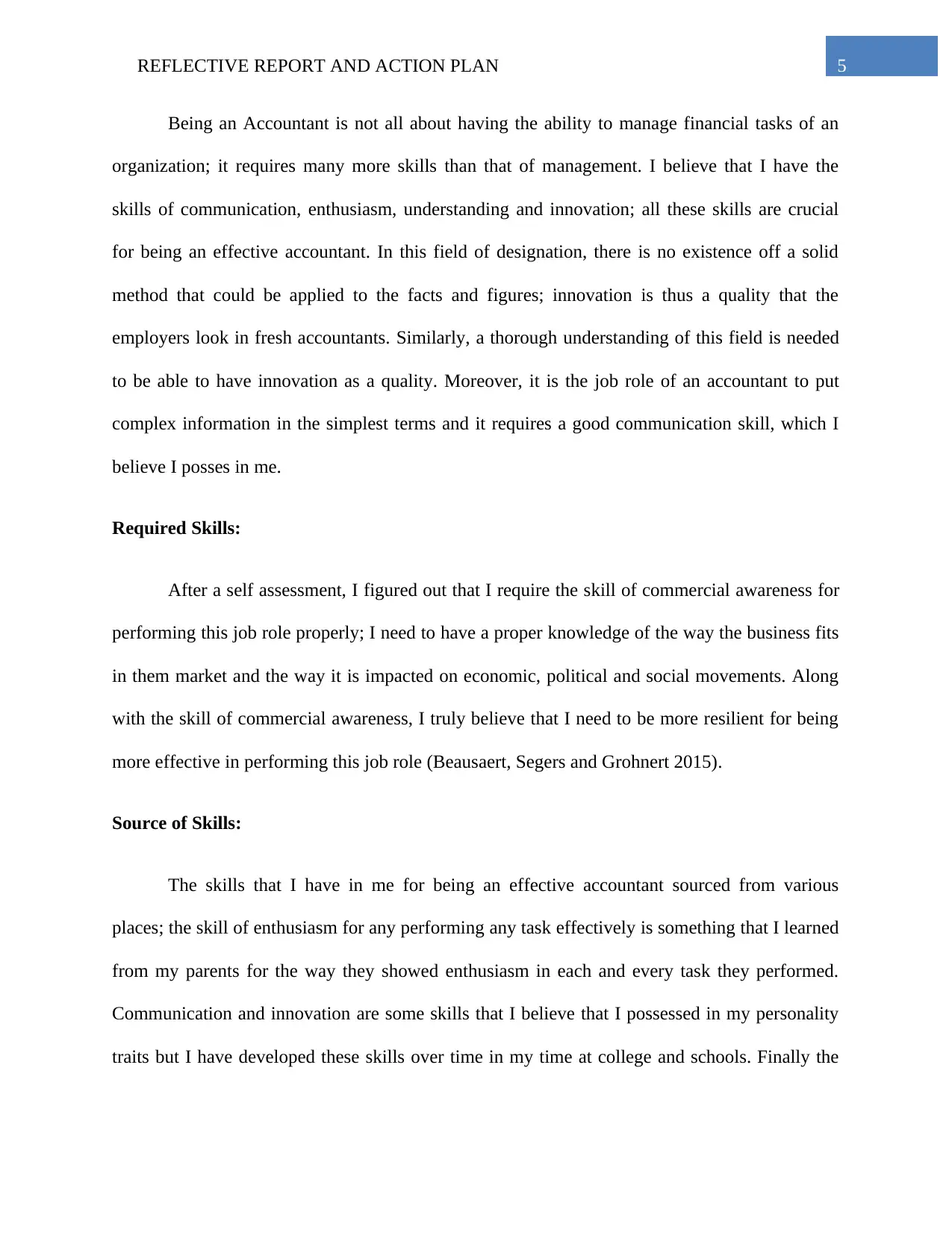
5REFLECTIVE REPORT AND ACTION PLAN
Being an Accountant is not all about having the ability to manage financial tasks of an
organization; it requires many more skills than that of management. I believe that I have the
skills of communication, enthusiasm, understanding and innovation; all these skills are crucial
for being an effective accountant. In this field of designation, there is no existence off a solid
method that could be applied to the facts and figures; innovation is thus a quality that the
employers look in fresh accountants. Similarly, a thorough understanding of this field is needed
to be able to have innovation as a quality. Moreover, it is the job role of an accountant to put
complex information in the simplest terms and it requires a good communication skill, which I
believe I posses in me.
Required Skills:
After a self assessment, I figured out that I require the skill of commercial awareness for
performing this job role properly; I need to have a proper knowledge of the way the business fits
in them market and the way it is impacted on economic, political and social movements. Along
with the skill of commercial awareness, I truly believe that I need to be more resilient for being
more effective in performing this job role (Beausaert, Segers and Grohnert 2015).
Source of Skills:
The skills that I have in me for being an effective accountant sourced from various
places; the skill of enthusiasm for any performing any task effectively is something that I learned
from my parents for the way they showed enthusiasm in each and every task they performed.
Communication and innovation are some skills that I believe that I possessed in my personality
traits but I have developed these skills over time in my time at college and schools. Finally the
Being an Accountant is not all about having the ability to manage financial tasks of an
organization; it requires many more skills than that of management. I believe that I have the
skills of communication, enthusiasm, understanding and innovation; all these skills are crucial
for being an effective accountant. In this field of designation, there is no existence off a solid
method that could be applied to the facts and figures; innovation is thus a quality that the
employers look in fresh accountants. Similarly, a thorough understanding of this field is needed
to be able to have innovation as a quality. Moreover, it is the job role of an accountant to put
complex information in the simplest terms and it requires a good communication skill, which I
believe I posses in me.
Required Skills:
After a self assessment, I figured out that I require the skill of commercial awareness for
performing this job role properly; I need to have a proper knowledge of the way the business fits
in them market and the way it is impacted on economic, political and social movements. Along
with the skill of commercial awareness, I truly believe that I need to be more resilient for being
more effective in performing this job role (Beausaert, Segers and Grohnert 2015).
Source of Skills:
The skills that I have in me for being an effective accountant sourced from various
places; the skill of enthusiasm for any performing any task effectively is something that I learned
from my parents for the way they showed enthusiasm in each and every task they performed.
Communication and innovation are some skills that I believe that I possessed in my personality
traits but I have developed these skills over time in my time at college and schools. Finally the
⊘ This is a preview!⊘
Do you want full access?
Subscribe today to unlock all pages.

Trusted by 1+ million students worldwide
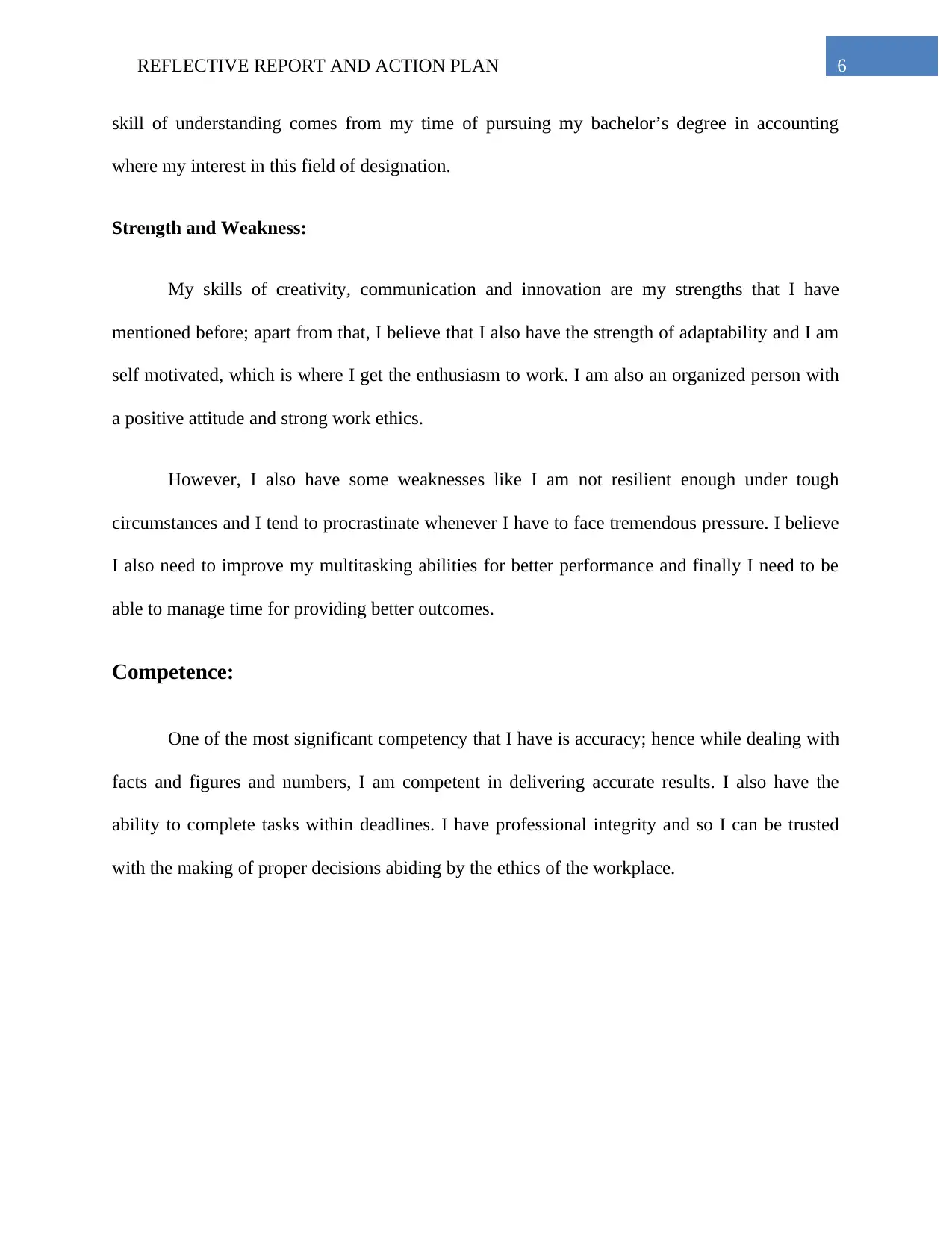
6REFLECTIVE REPORT AND ACTION PLAN
skill of understanding comes from my time of pursuing my bachelor’s degree in accounting
where my interest in this field of designation.
Strength and Weakness:
My skills of creativity, communication and innovation are my strengths that I have
mentioned before; apart from that, I believe that I also have the strength of adaptability and I am
self motivated, which is where I get the enthusiasm to work. I am also an organized person with
a positive attitude and strong work ethics.
However, I also have some weaknesses like I am not resilient enough under tough
circumstances and I tend to procrastinate whenever I have to face tremendous pressure. I believe
I also need to improve my multitasking abilities for better performance and finally I need to be
able to manage time for providing better outcomes.
Competence:
One of the most significant competency that I have is accuracy; hence while dealing with
facts and figures and numbers, I am competent in delivering accurate results. I also have the
ability to complete tasks within deadlines. I have professional integrity and so I can be trusted
with the making of proper decisions abiding by the ethics of the workplace.
skill of understanding comes from my time of pursuing my bachelor’s degree in accounting
where my interest in this field of designation.
Strength and Weakness:
My skills of creativity, communication and innovation are my strengths that I have
mentioned before; apart from that, I believe that I also have the strength of adaptability and I am
self motivated, which is where I get the enthusiasm to work. I am also an organized person with
a positive attitude and strong work ethics.
However, I also have some weaknesses like I am not resilient enough under tough
circumstances and I tend to procrastinate whenever I have to face tremendous pressure. I believe
I also need to improve my multitasking abilities for better performance and finally I need to be
able to manage time for providing better outcomes.
Competence:
One of the most significant competency that I have is accuracy; hence while dealing with
facts and figures and numbers, I am competent in delivering accurate results. I also have the
ability to complete tasks within deadlines. I have professional integrity and so I can be trusted
with the making of proper decisions abiding by the ethics of the workplace.
Paraphrase This Document
Need a fresh take? Get an instant paraphrase of this document with our AI Paraphraser
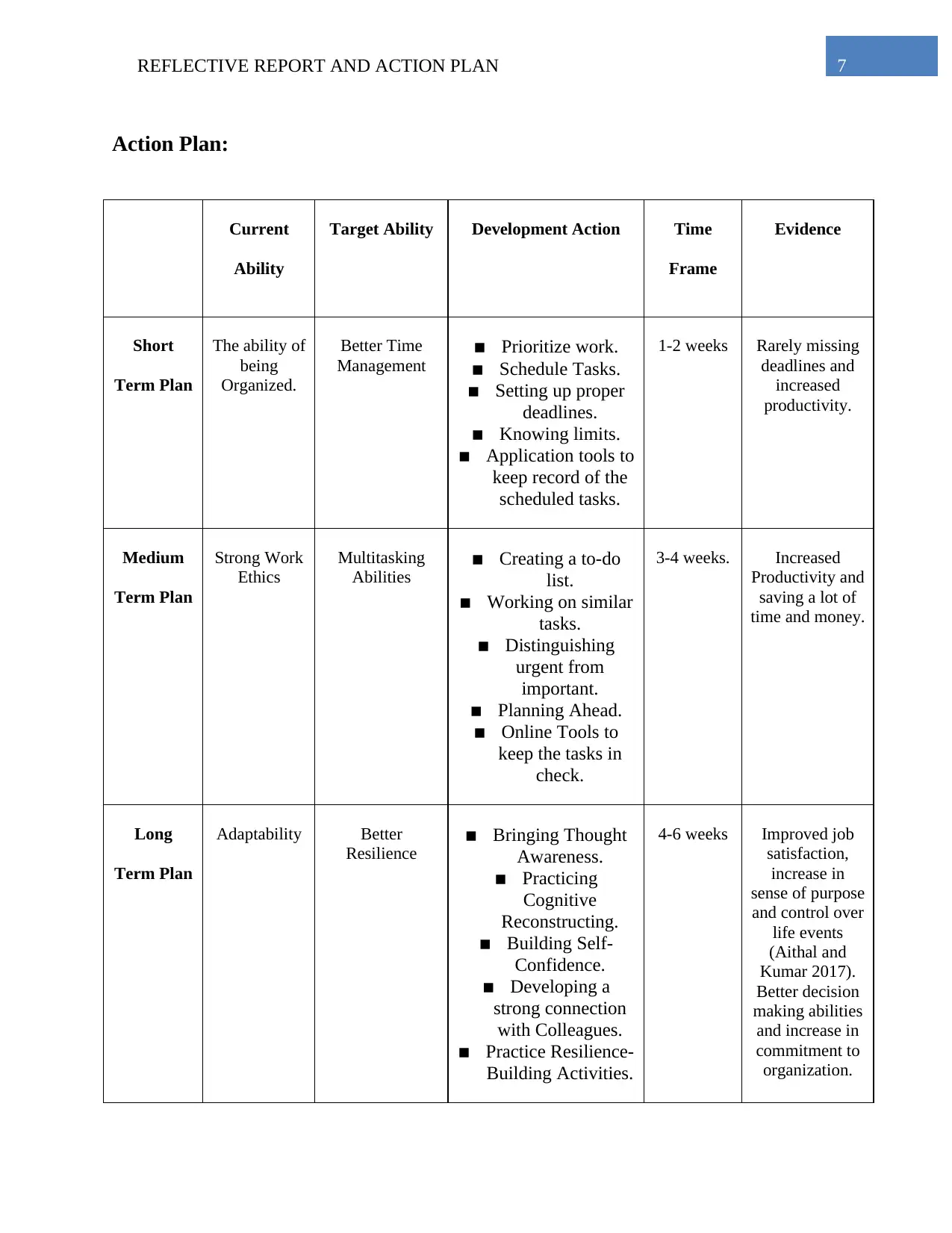
7REFLECTIVE REPORT AND ACTION PLAN
Action Plan:
Current
Ability
Target Ability Development Action Time
Frame
Evidence
Short
Term Plan
The ability of
being
Organized.
Better Time
Management
▪ Prioritize work.
▪ Schedule Tasks.
▪ Setting up proper
deadlines.
▪ Knowing limits.
▪ Application tools to
keep record of the
scheduled tasks.
1-2 weeks Rarely missing
deadlines and
increased
productivity.
Medium
Term Plan
Strong Work
Ethics
Multitasking
Abilities
▪ Creating a to-do
list.
▪ Working on similar
tasks.
▪ Distinguishing
urgent from
important.
▪ Planning Ahead.
▪ Online Tools to
keep the tasks in
check.
3-4 weeks. Increased
Productivity and
saving a lot of
time and money.
Long
Term Plan
Adaptability Better
Resilience
▪ Bringing Thought
Awareness.
▪ Practicing
Cognitive
Reconstructing.
▪ Building Self-
Confidence.
▪ Developing a
strong connection
with Colleagues.
▪ Practice Resilience-
Building Activities.
4-6 weeks Improved job
satisfaction,
increase in
sense of purpose
and control over
life events
(Aithal and
Kumar 2017).
Better decision
making abilities
and increase in
commitment to
organization.
Action Plan:
Current
Ability
Target Ability Development Action Time
Frame
Evidence
Short
Term Plan
The ability of
being
Organized.
Better Time
Management
▪ Prioritize work.
▪ Schedule Tasks.
▪ Setting up proper
deadlines.
▪ Knowing limits.
▪ Application tools to
keep record of the
scheduled tasks.
1-2 weeks Rarely missing
deadlines and
increased
productivity.
Medium
Term Plan
Strong Work
Ethics
Multitasking
Abilities
▪ Creating a to-do
list.
▪ Working on similar
tasks.
▪ Distinguishing
urgent from
important.
▪ Planning Ahead.
▪ Online Tools to
keep the tasks in
check.
3-4 weeks. Increased
Productivity and
saving a lot of
time and money.
Long
Term Plan
Adaptability Better
Resilience
▪ Bringing Thought
Awareness.
▪ Practicing
Cognitive
Reconstructing.
▪ Building Self-
Confidence.
▪ Developing a
strong connection
with Colleagues.
▪ Practice Resilience-
Building Activities.
4-6 weeks Improved job
satisfaction,
increase in
sense of purpose
and control over
life events
(Aithal and
Kumar 2017).
Better decision
making abilities
and increase in
commitment to
organization.
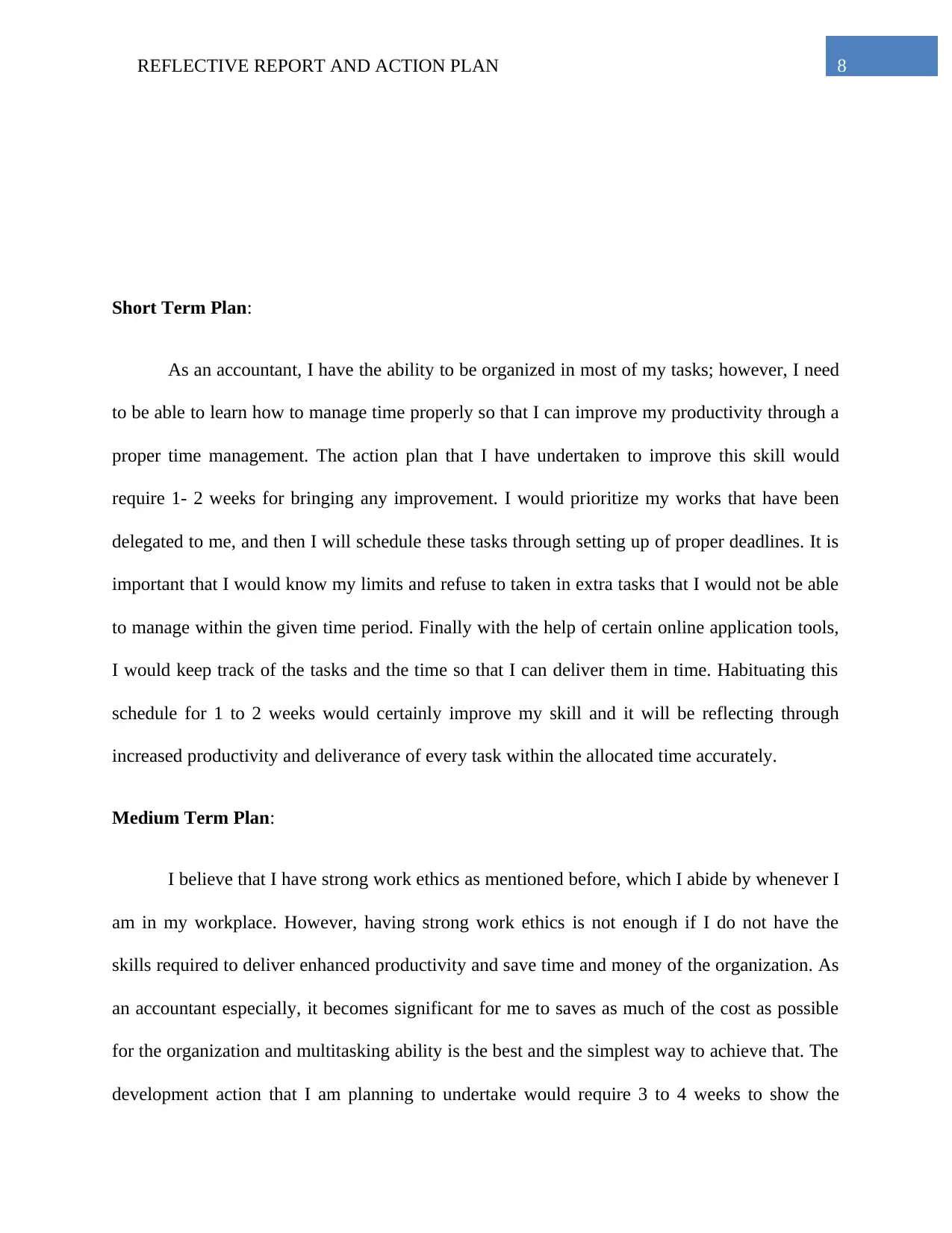
8REFLECTIVE REPORT AND ACTION PLAN
Short Term Plan:
As an accountant, I have the ability to be organized in most of my tasks; however, I need
to be able to learn how to manage time properly so that I can improve my productivity through a
proper time management. The action plan that I have undertaken to improve this skill would
require 1- 2 weeks for bringing any improvement. I would prioritize my works that have been
delegated to me, and then I will schedule these tasks through setting up of proper deadlines. It is
important that I would know my limits and refuse to taken in extra tasks that I would not be able
to manage within the given time period. Finally with the help of certain online application tools,
I would keep track of the tasks and the time so that I can deliver them in time. Habituating this
schedule for 1 to 2 weeks would certainly improve my skill and it will be reflecting through
increased productivity and deliverance of every task within the allocated time accurately.
Medium Term Plan:
I believe that I have strong work ethics as mentioned before, which I abide by whenever I
am in my workplace. However, having strong work ethics is not enough if I do not have the
skills required to deliver enhanced productivity and save time and money of the organization. As
an accountant especially, it becomes significant for me to saves as much of the cost as possible
for the organization and multitasking ability is the best and the simplest way to achieve that. The
development action that I am planning to undertake would require 3 to 4 weeks to show the
Short Term Plan:
As an accountant, I have the ability to be organized in most of my tasks; however, I need
to be able to learn how to manage time properly so that I can improve my productivity through a
proper time management. The action plan that I have undertaken to improve this skill would
require 1- 2 weeks for bringing any improvement. I would prioritize my works that have been
delegated to me, and then I will schedule these tasks through setting up of proper deadlines. It is
important that I would know my limits and refuse to taken in extra tasks that I would not be able
to manage within the given time period. Finally with the help of certain online application tools,
I would keep track of the tasks and the time so that I can deliver them in time. Habituating this
schedule for 1 to 2 weeks would certainly improve my skill and it will be reflecting through
increased productivity and deliverance of every task within the allocated time accurately.
Medium Term Plan:
I believe that I have strong work ethics as mentioned before, which I abide by whenever I
am in my workplace. However, having strong work ethics is not enough if I do not have the
skills required to deliver enhanced productivity and save time and money of the organization. As
an accountant especially, it becomes significant for me to saves as much of the cost as possible
for the organization and multitasking ability is the best and the simplest way to achieve that. The
development action that I am planning to undertake would require 3 to 4 weeks to show the
⊘ This is a preview!⊘
Do you want full access?
Subscribe today to unlock all pages.

Trusted by 1+ million students worldwide
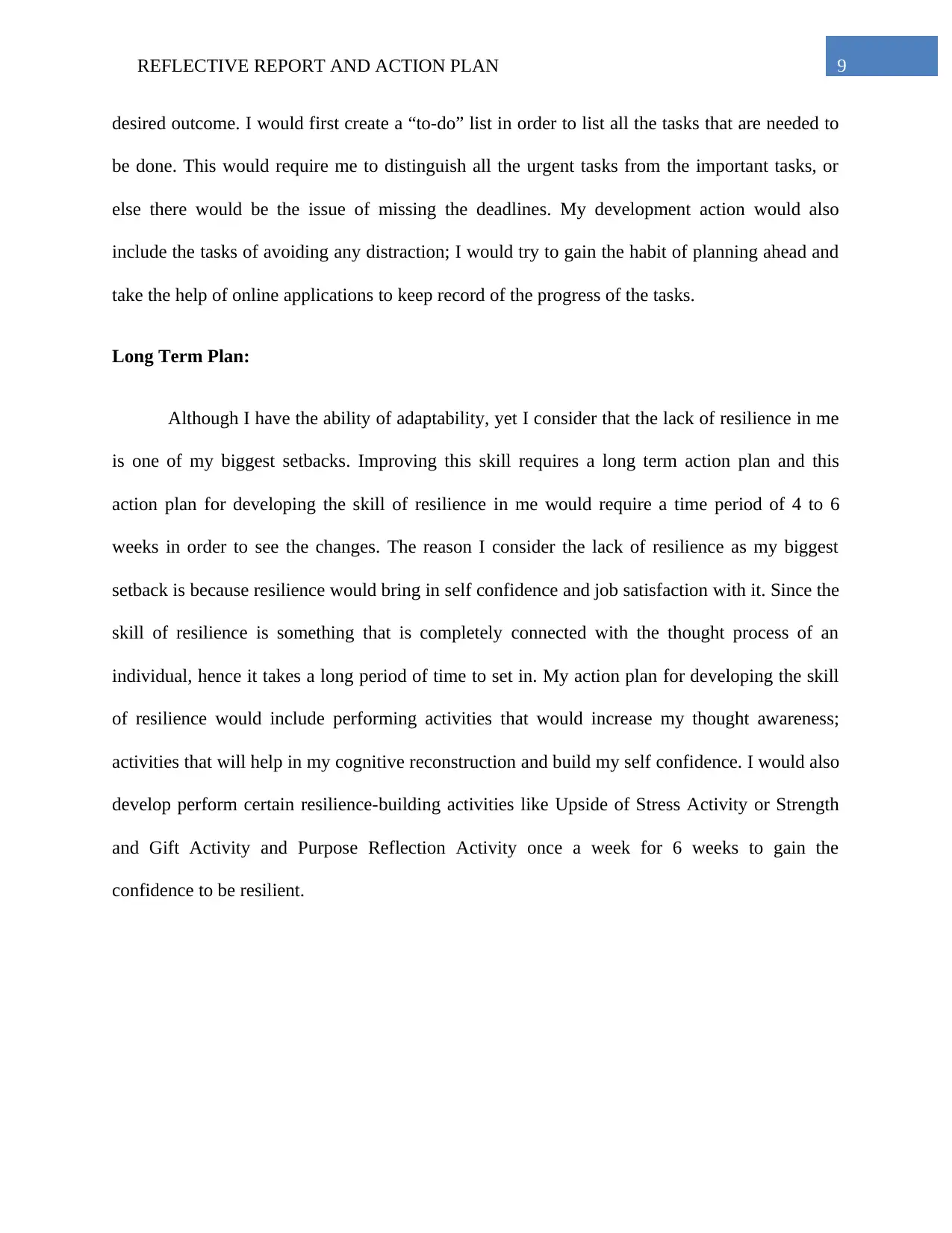
9REFLECTIVE REPORT AND ACTION PLAN
desired outcome. I would first create a “to-do” list in order to list all the tasks that are needed to
be done. This would require me to distinguish all the urgent tasks from the important tasks, or
else there would be the issue of missing the deadlines. My development action would also
include the tasks of avoiding any distraction; I would try to gain the habit of planning ahead and
take the help of online applications to keep record of the progress of the tasks.
Long Term Plan:
Although I have the ability of adaptability, yet I consider that the lack of resilience in me
is one of my biggest setbacks. Improving this skill requires a long term action plan and this
action plan for developing the skill of resilience in me would require a time period of 4 to 6
weeks in order to see the changes. The reason I consider the lack of resilience as my biggest
setback is because resilience would bring in self confidence and job satisfaction with it. Since the
skill of resilience is something that is completely connected with the thought process of an
individual, hence it takes a long period of time to set in. My action plan for developing the skill
of resilience would include performing activities that would increase my thought awareness;
activities that will help in my cognitive reconstruction and build my self confidence. I would also
develop perform certain resilience-building activities like Upside of Stress Activity or Strength
and Gift Activity and Purpose Reflection Activity once a week for 6 weeks to gain the
confidence to be resilient.
desired outcome. I would first create a “to-do” list in order to list all the tasks that are needed to
be done. This would require me to distinguish all the urgent tasks from the important tasks, or
else there would be the issue of missing the deadlines. My development action would also
include the tasks of avoiding any distraction; I would try to gain the habit of planning ahead and
take the help of online applications to keep record of the progress of the tasks.
Long Term Plan:
Although I have the ability of adaptability, yet I consider that the lack of resilience in me
is one of my biggest setbacks. Improving this skill requires a long term action plan and this
action plan for developing the skill of resilience in me would require a time period of 4 to 6
weeks in order to see the changes. The reason I consider the lack of resilience as my biggest
setback is because resilience would bring in self confidence and job satisfaction with it. Since the
skill of resilience is something that is completely connected with the thought process of an
individual, hence it takes a long period of time to set in. My action plan for developing the skill
of resilience would include performing activities that would increase my thought awareness;
activities that will help in my cognitive reconstruction and build my self confidence. I would also
develop perform certain resilience-building activities like Upside of Stress Activity or Strength
and Gift Activity and Purpose Reflection Activity once a week for 6 weeks to gain the
confidence to be resilient.
Paraphrase This Document
Need a fresh take? Get an instant paraphrase of this document with our AI Paraphraser
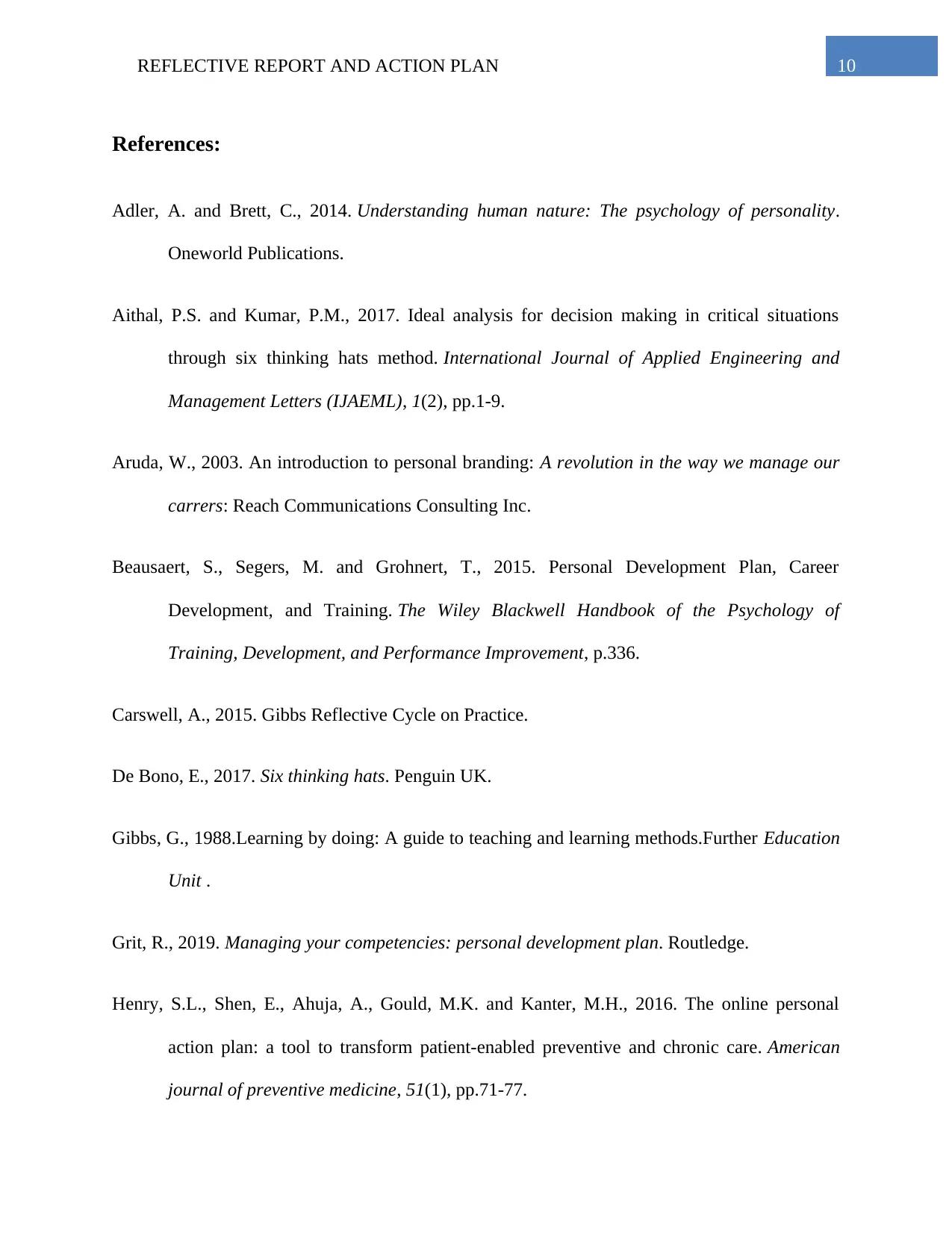
10REFLECTIVE REPORT AND ACTION PLAN
References:
Adler, A. and Brett, C., 2014. Understanding human nature: The psychology of personality.
Oneworld Publications.
Aithal, P.S. and Kumar, P.M., 2017. Ideal analysis for decision making in critical situations
through six thinking hats method. International Journal of Applied Engineering and
Management Letters (IJAEML), 1(2), pp.1-9.
Aruda, W., 2003. An introduction to personal branding: A revolution in the way we manage our
carrers: Reach Communications Consulting Inc.
Beausaert, S., Segers, M. and Grohnert, T., 2015. Personal Development Plan, Career
Development, and Training. The Wiley Blackwell Handbook of the Psychology of
Training, Development, and Performance Improvement, p.336.
Carswell, A., 2015. Gibbs Reflective Cycle on Practice.
De Bono, E., 2017. Six thinking hats. Penguin UK.
Gibbs, G., 1988.Learning by doing: A guide to teaching and learning methods.Further Education
Unit .
Grit, R., 2019. Managing your competencies: personal development plan. Routledge.
Henry, S.L., Shen, E., Ahuja, A., Gould, M.K. and Kanter, M.H., 2016. The online personal
action plan: a tool to transform patient-enabled preventive and chronic care. American
journal of preventive medicine, 51(1), pp.71-77.
References:
Adler, A. and Brett, C., 2014. Understanding human nature: The psychology of personality.
Oneworld Publications.
Aithal, P.S. and Kumar, P.M., 2017. Ideal analysis for decision making in critical situations
through six thinking hats method. International Journal of Applied Engineering and
Management Letters (IJAEML), 1(2), pp.1-9.
Aruda, W., 2003. An introduction to personal branding: A revolution in the way we manage our
carrers: Reach Communications Consulting Inc.
Beausaert, S., Segers, M. and Grohnert, T., 2015. Personal Development Plan, Career
Development, and Training. The Wiley Blackwell Handbook of the Psychology of
Training, Development, and Performance Improvement, p.336.
Carswell, A., 2015. Gibbs Reflective Cycle on Practice.
De Bono, E., 2017. Six thinking hats. Penguin UK.
Gibbs, G., 1988.Learning by doing: A guide to teaching and learning methods.Further Education
Unit .
Grit, R., 2019. Managing your competencies: personal development plan. Routledge.
Henry, S.L., Shen, E., Ahuja, A., Gould, M.K. and Kanter, M.H., 2016. The online personal
action plan: a tool to transform patient-enabled preventive and chronic care. American
journal of preventive medicine, 51(1), pp.71-77.
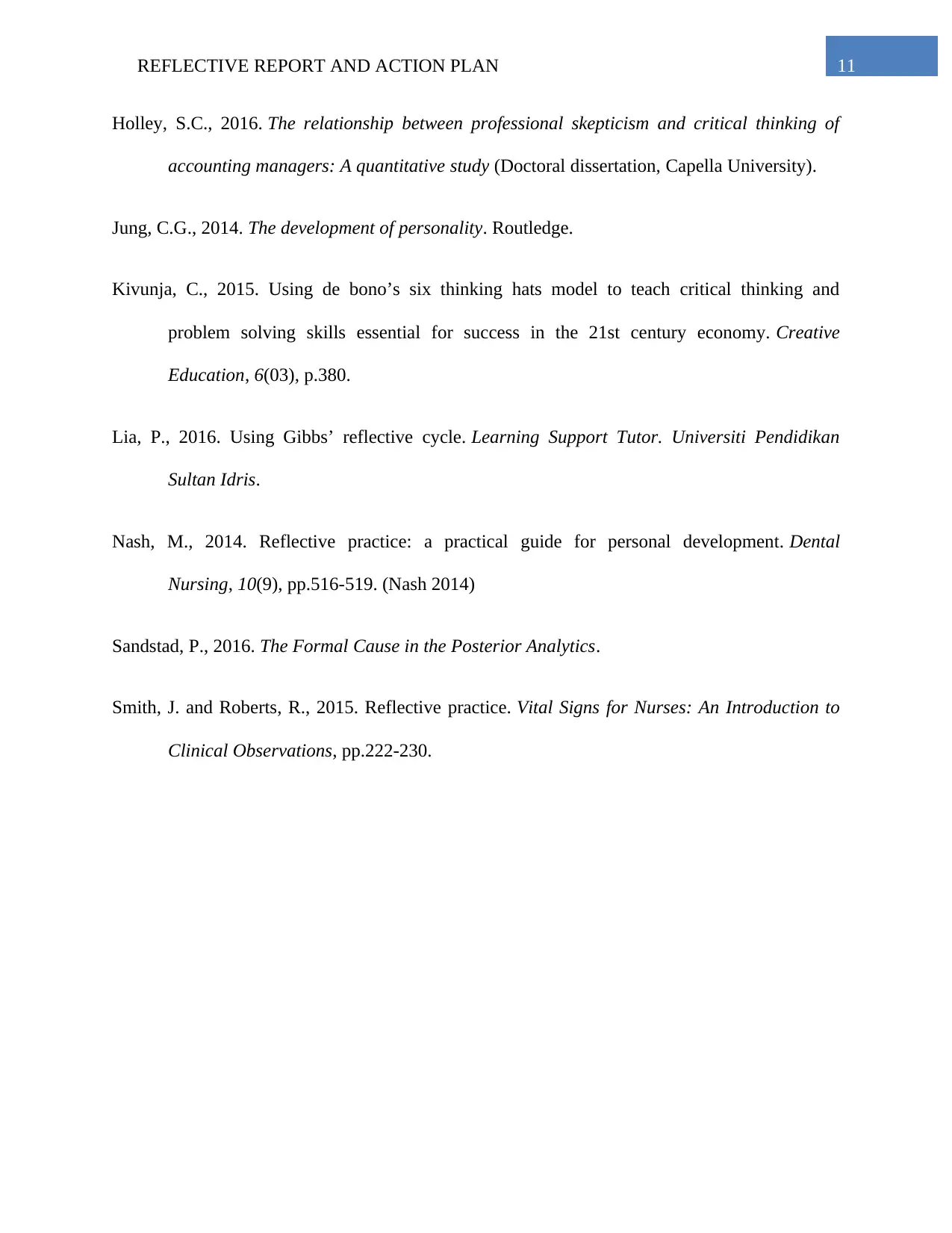
11REFLECTIVE REPORT AND ACTION PLAN
Holley, S.C., 2016. The relationship between professional skepticism and critical thinking of
accounting managers: A quantitative study (Doctoral dissertation, Capella University).
Jung, C.G., 2014. The development of personality. Routledge.
Kivunja, C., 2015. Using de bono’s six thinking hats model to teach critical thinking and
problem solving skills essential for success in the 21st century economy. Creative
Education, 6(03), p.380.
Lia, P., 2016. Using Gibbs’ reflective cycle. Learning Support Tutor. Universiti Pendidikan
Sultan Idris.
Nash, M., 2014. Reflective practice: a practical guide for personal development. Dental
Nursing, 10(9), pp.516-519. (Nash 2014)
Sandstad, P., 2016. The Formal Cause in the Posterior Analytics.
Smith, J. and Roberts, R., 2015. Reflective practice. Vital Signs for Nurses: An Introduction to
Clinical Observations, pp.222-230.
Holley, S.C., 2016. The relationship between professional skepticism and critical thinking of
accounting managers: A quantitative study (Doctoral dissertation, Capella University).
Jung, C.G., 2014. The development of personality. Routledge.
Kivunja, C., 2015. Using de bono’s six thinking hats model to teach critical thinking and
problem solving skills essential for success in the 21st century economy. Creative
Education, 6(03), p.380.
Lia, P., 2016. Using Gibbs’ reflective cycle. Learning Support Tutor. Universiti Pendidikan
Sultan Idris.
Nash, M., 2014. Reflective practice: a practical guide for personal development. Dental
Nursing, 10(9), pp.516-519. (Nash 2014)
Sandstad, P., 2016. The Formal Cause in the Posterior Analytics.
Smith, J. and Roberts, R., 2015. Reflective practice. Vital Signs for Nurses: An Introduction to
Clinical Observations, pp.222-230.
⊘ This is a preview!⊘
Do you want full access?
Subscribe today to unlock all pages.

Trusted by 1+ million students worldwide
1 out of 12
Related Documents
Your All-in-One AI-Powered Toolkit for Academic Success.
+13062052269
info@desklib.com
Available 24*7 on WhatsApp / Email
![[object Object]](/_next/static/media/star-bottom.7253800d.svg)
Unlock your academic potential
© 2024 | Zucol Services PVT LTD | All rights reserved.



